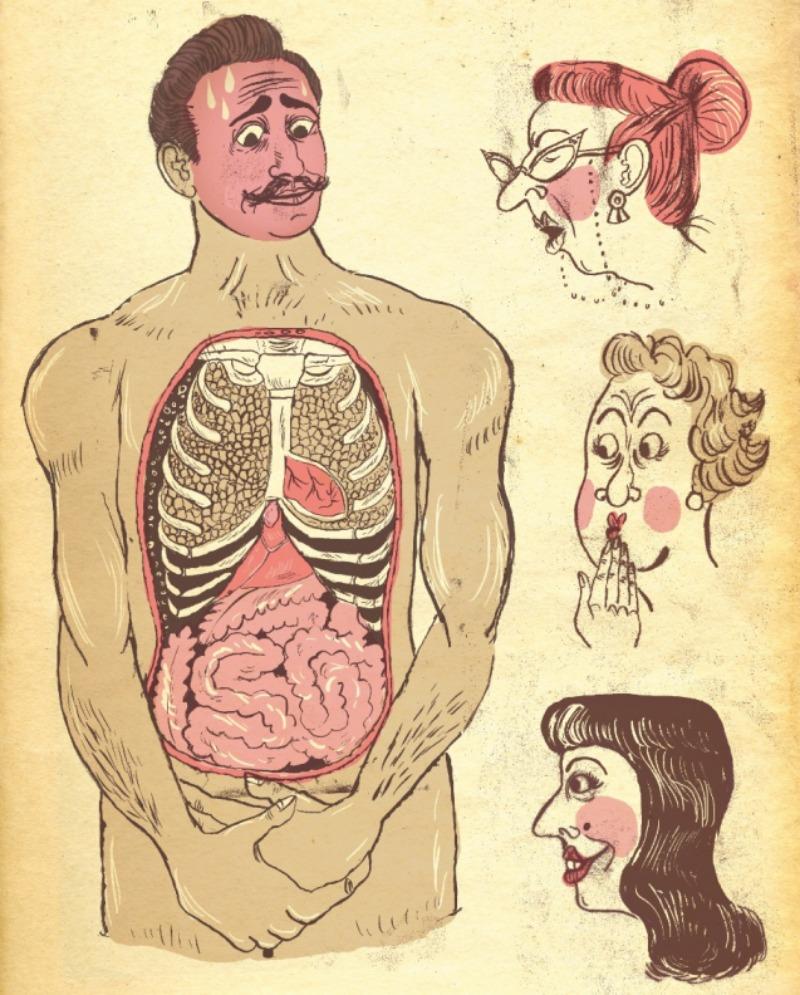Why Do We Blush? and Other Scientific Mysteries
What is antimatter? Why do we age? How do migrating animals find their way back home? These are just some of the 75 questions answered in The Where, the Why, and the How. What makes this book more than a technical Q&A, however, is that the answers come from both scientists and artists.
“Many people see science as a dry, robotic enterprise without a lot of emotion or wonder in it, which is tragically inaccurate,” says Brett Marroqun, a PhD candidate in the psychology department at Yale University and a contributor to the book. “This project makes it really clear in a neat way that regardless of our approach to understanding things, artists and scientists—and humans in general—are united by excitement and wonder about the unknown.”
The team behind the book (designer Jenny Volvovski, illustrator Julia Rothman and animator Matt Lamothe) was inspired by the elegant diagrams and scientific illustrations found in old biology books. Their update on the idea combines text written by scientists from major institutions including Yale, Rutgers, and the University of California at Berkeley and well-known illustrators (including Marc Bell, Josh Cochran, and Susie Ghahremani). The result is scientific, yet with tongue planted firmly in cheek. Why do we blush? includes a discussion of blood vessels and the sympathetic nervous system, along with a drawing of a naked man with his internal organs exposed (you’d blush too).
See more images from the book below.
The questions range from the common (Why do we yawn?) to the obscure (Why do primates eat plants that produce steroid mimics?) but they share a common characteristic: they’re all still under investigation. “There’s so much of science that doesn’t have a definitive answer,” Volvovski says. “We pretty much learned all of science doesn’t have a definitive answer,” adds Rothman. But that was part of the fun. “We wanted the artists to sort of answer the question themselves,” Rothman explains. “We told them they could illustrate the piece directly or they could come up with their own solution.”

Once the authors had the scientific explanation in hand, they carefully paired the artists with the topic that would fit them best. For example, Alex Eben Meyer is known for his cartoony style. So the authors gave him, Why do pigeons bob their heads when they walk? “It was basically perfect for me,” he says. Meyer immersed himself in YouTube videos of pigeons walking in slow motion. “For my piece, I was trying to recreate that motion without actually showing motion.”
Dave Zackin (Why do we hiccup?) was relieved to receive a question he could relate to. His wife, who is in medical school, gave him a crash course in the scientific terminology. “I wrote down everything I could think of,” he says. And once he’d completed his painting, a head with its tongue sticking out, “I tried to cram in all of the text that I’d written down,” he says, “almost like a flow chart.”
The artist-scientist pairs were geographically scattered and most never spoke about their shared assignment. But Marroqun thinks that improved the process. “It means we all spoke our own languages,” he says. Marroqun answered three questions, including What causes depression? In the illustration, by Maxwell Holyoke-Hirsch, “I can see the tension between internal and external factors that I emphasized in my piece,” Marroqun says. “Maxwell’s visual piece is so striking and beautiful that it makes the scientific explanation connect with an emotional resonance that only art can do.”
Slideshow: The Where, the Why, and the How
Every day, reporters and producers at The World are hard at work bringing you human-centered news from across the globe. But we can’t do it without you. We need your support to ensure we can continue this work for another year.
Make a gift today, and you’ll help us unlock a matching gift of $67,000!
